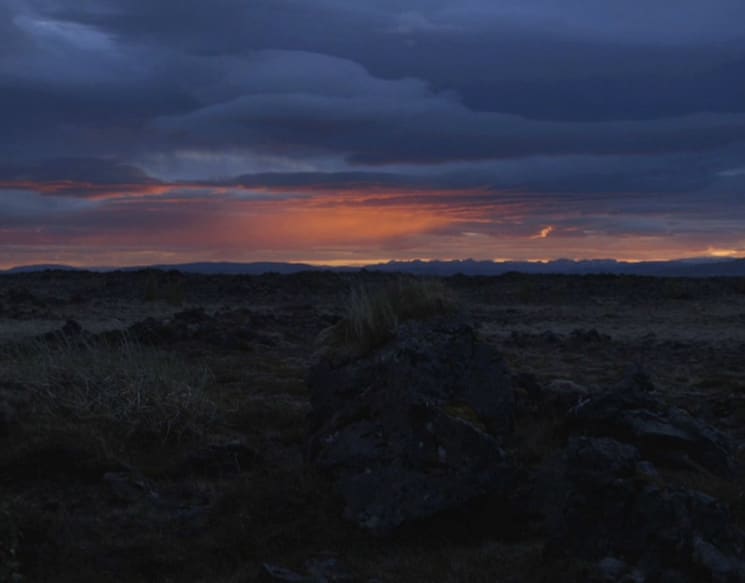Horizon, the title of this mostly conventional and straightforward subject-based documentary, refers to the stylistic preoccupation of Icelandic landscape artist, Georg Guðni. Before passing in 2011, Guðni was renowned regionally, finding success with the landscape form straight out of school and throughout his career. Actor Viggo Mortensen, who collaborated on a book with Guðni and supported him on the subsequent publicity tour, describes the appeal of his work as "strange familiarity," while experts on the subject use other various methods to try and explain the style and why people find it so magnetic.
Director Fridrik Thor Fridriksson, whose narrative film, Children of Nature, was nominated for a Best Foreign Language Oscar back in 1991, spends the duration of Horizon trying to articulate exactly what is unique about Guðni's work. Extensive archival interview footage with Guðni outlines his interest in capturing not only a horizon, but the space, colours and minutiae in between his eye and that perceived linear distinction, blending his emotional experience with the image and the colours of the ground and sky to give an impression of the image rather than a realist outline.
Experts interviewed analyze his use of colour and the amount of layering that goes into each painting, noting that even though his style seemingly appears to be the gradual blending of colours in a linear fashion, there's an abundance of preparation and structure that goes into capturing the specific structure of the final product. Fridriksson also presents Guðni's career in a linear fashion, showing the evolution of landscape to oblique colour interpretations of landscapes to an interest in mountains, and how they obscure and interrupt a landscape. And since Guðni's work does have a rapturous quality to it, these explanations and contextualization aid in understanding and appreciating what we're seeing.
The issue with Horizon stems from the feature-length format and Fridriksson's rather standard take on the documentary form. Stylistically, the structure vacillates between interviews, filmed shots of landscapes and Guðni's portraits of landscapes, giving us a comparative visual between the inspiration for the art that we're being shown. Beyond this visual juxtaposition, there's nothing to help immerse us in the artistic landscape or allow us to engage with, and interpret, the images. Where a documentary like Gerhard Richter Painting experimented with the form to reinforce the objective of the artist, Fridriksson's style is rather literal and dry.
Similarly, once everyone has a go at trying to articulate what they appreciate about Guðni's art, which comprises about 15 minutes of the film, there's little ground left to cover. This means that most of the runtime is spent on ideas being rearticulated in various ways with more static images of paintings to fill up the runtime. The end result is an oft-redundant documentary that could have packed more of a punch with a more concise, and appropriate, short film runtime. Still, Guðni's work is quite intriguing and it's great that efforts are being made to get it added exposure.
(Horizon)Director Fridrik Thor Fridriksson, whose narrative film, Children of Nature, was nominated for a Best Foreign Language Oscar back in 1991, spends the duration of Horizon trying to articulate exactly what is unique about Guðni's work. Extensive archival interview footage with Guðni outlines his interest in capturing not only a horizon, but the space, colours and minutiae in between his eye and that perceived linear distinction, blending his emotional experience with the image and the colours of the ground and sky to give an impression of the image rather than a realist outline.
Experts interviewed analyze his use of colour and the amount of layering that goes into each painting, noting that even though his style seemingly appears to be the gradual blending of colours in a linear fashion, there's an abundance of preparation and structure that goes into capturing the specific structure of the final product. Fridriksson also presents Guðni's career in a linear fashion, showing the evolution of landscape to oblique colour interpretations of landscapes to an interest in mountains, and how they obscure and interrupt a landscape. And since Guðni's work does have a rapturous quality to it, these explanations and contextualization aid in understanding and appreciating what we're seeing.
The issue with Horizon stems from the feature-length format and Fridriksson's rather standard take on the documentary form. Stylistically, the structure vacillates between interviews, filmed shots of landscapes and Guðni's portraits of landscapes, giving us a comparative visual between the inspiration for the art that we're being shown. Beyond this visual juxtaposition, there's nothing to help immerse us in the artistic landscape or allow us to engage with, and interpret, the images. Where a documentary like Gerhard Richter Painting experimented with the form to reinforce the objective of the artist, Fridriksson's style is rather literal and dry.
Similarly, once everyone has a go at trying to articulate what they appreciate about Guðni's art, which comprises about 15 minutes of the film, there's little ground left to cover. This means that most of the runtime is spent on ideas being rearticulated in various ways with more static images of paintings to fill up the runtime. The end result is an oft-redundant documentary that could have packed more of a punch with a more concise, and appropriate, short film runtime. Still, Guðni's work is quite intriguing and it's great that efforts are being made to get it added exposure.
